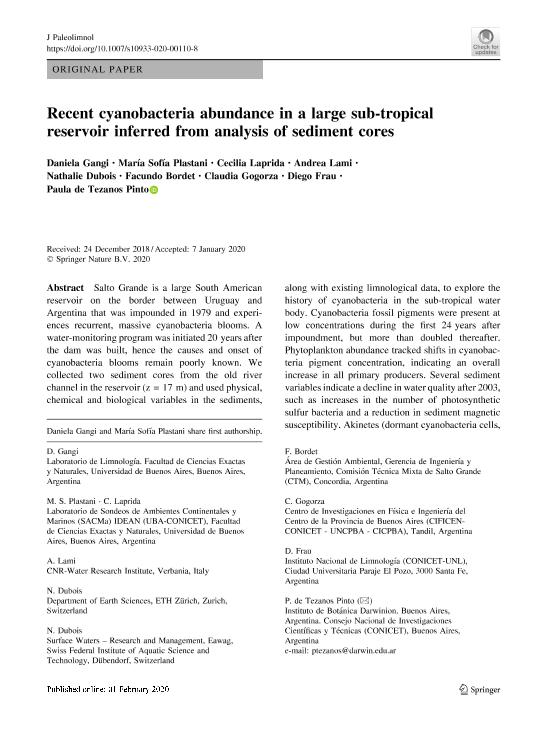Artículo
Recent cyanobacteria abundance in a large sub-tropical reservoir inferred from analysis of sediment cores
Gangi, Daniela; Plastani, María Sofía ; Laprida, Cecilia
; Laprida, Cecilia ; Lami, Andrea; Dubois, Nathalie; Bordet, Facundo; Gogorza, Claudia Susana
; Lami, Andrea; Dubois, Nathalie; Bordet, Facundo; Gogorza, Claudia Susana ; Frau, Diego
; Frau, Diego ; de Tezanos Pinto, Paula
; de Tezanos Pinto, Paula
 ; Laprida, Cecilia
; Laprida, Cecilia ; Lami, Andrea; Dubois, Nathalie; Bordet, Facundo; Gogorza, Claudia Susana
; Lami, Andrea; Dubois, Nathalie; Bordet, Facundo; Gogorza, Claudia Susana ; Frau, Diego
; Frau, Diego ; de Tezanos Pinto, Paula
; de Tezanos Pinto, Paula
Fecha de publicación:
02/2020
Editorial:
Springer
Revista:
Journal Of Paleolimnology
ISSN:
0921-2728
Idioma:
Inglés
Tipo de recurso:
Artículo publicado
Clasificación temática:
Resumen
Salto Grande is a large South American reservoir on the border between Uruguay and Argentina that was impounded in 1979 and experiences recurrent, massive cyanobacteria blooms. A water-monitoring program was initiated 20 years after the dam was built, hence the causes and onset of cyanobacteria blooms remain poorly known. We collected two sediment cores from the old river channel in the reservoir (z = 17 m) and used physical, chemical and biological variables in the sediments, along with existing limnological data, to explore the history of cyanobacteria in the sub-tropical water body. Cyanobacteria fossil pigments were present at low concentrations during the first 24 years after impoundment, but more than doubled thereafter. Phytoplankton abundance tracked shifts in cyanobacteria pigment concentration, indicating an overall increase in all primary producers. Several sediment variables indicate a decline in water quality after 2003, such as increases in the number of photosynthetic sulfur bacteria and a reduction in sediment magnetic susceptibility. Akinetes (dormant cyanobacteria cells, Order Nostocales) in recent reservoir deposits were abundant and five species germinated under laboratory conditions, underscoring the ability of akinetes to initiate cyanobacteria blooms. The germinated assemblage reflected closely the composition of cyanobacteria blooms in the reservoir. Recorded increases in air temperature and decreases in wind speed, together with other variables (e.g. nutrients), can promote the large, recurrent cyanobacteria blooms. Invasion of the bivalve Limnoperna fortunei apparently promoted cyanobacteria blooms by preferential feeding on other phytoplankton taxa, and perhaps by altering nutrient concentrations and ratios. This work highlights the potential for using multiple variables in sediment cores from large reservoirs to better understand the responses of biota to multiple environmental stressors.
Palabras clave:
AKINETES
,
CYANOBACTERIA
,
PALEOLIMNOLOGY
,
PIGMENTS
,
RESERVOIR
Archivos asociados
Licencia
Identificadores
Colecciones
Articulos(CIFICEN)
Articulos de CENTRO DE INV. EN FISICA E INGENIERIA DEL CENTRO DE LA PCIA. DE BS. AS.
Articulos de CENTRO DE INV. EN FISICA E INGENIERIA DEL CENTRO DE LA PCIA. DE BS. AS.
Articulos(IBODA)
Articulos de INST.DE BOTANICA DARWINION (I)
Articulos de INST.DE BOTANICA DARWINION (I)
Articulos(IDEAN)
Articulos de INSTITUTO DE ESTUDIOS ANDINOS "DON PABLO GROEBER"
Articulos de INSTITUTO DE ESTUDIOS ANDINOS "DON PABLO GROEBER"
Articulos(INALI)
Articulos de INST.NAC.DE LIMNOLOGIA (I)
Articulos de INST.NAC.DE LIMNOLOGIA (I)
Citación
Gangi, Daniela; Plastani, María Sofía; Laprida, Cecilia; Lami, Andrea; Dubois, Nathalie; et al.; Recent cyanobacteria abundance in a large sub-tropical reservoir inferred from analysis of sediment cores; Springer; Journal Of Paleolimnology; 63; 3; 2-2020; 195-209
Compartir
Altmétricas



